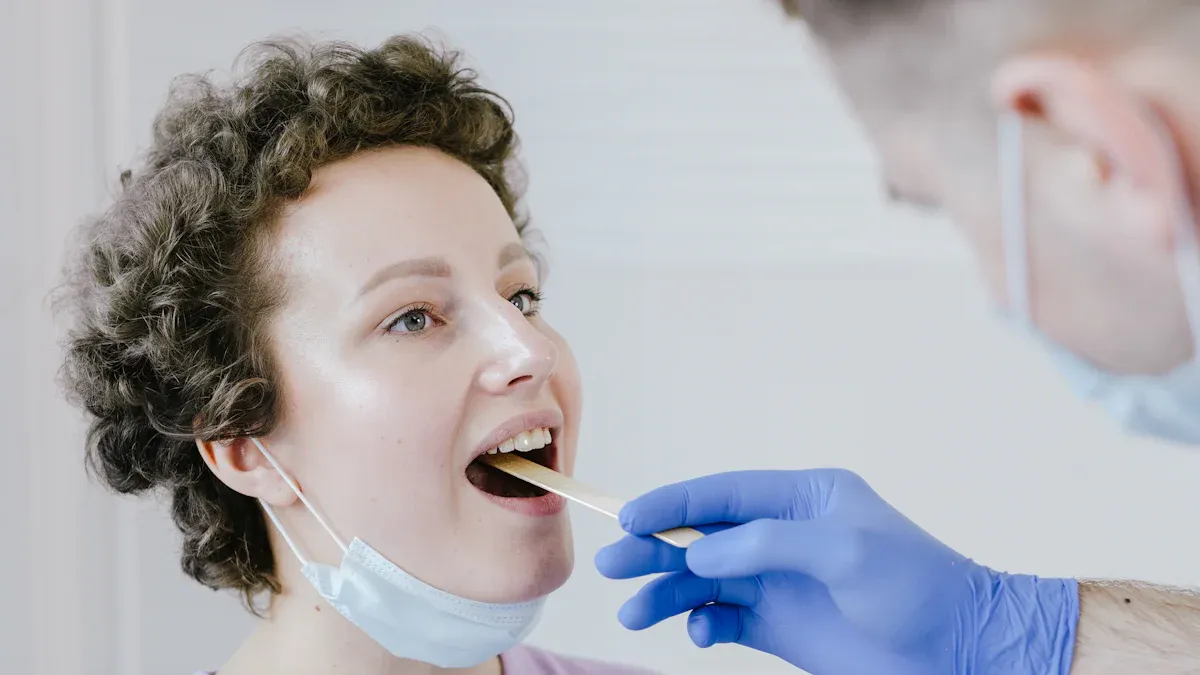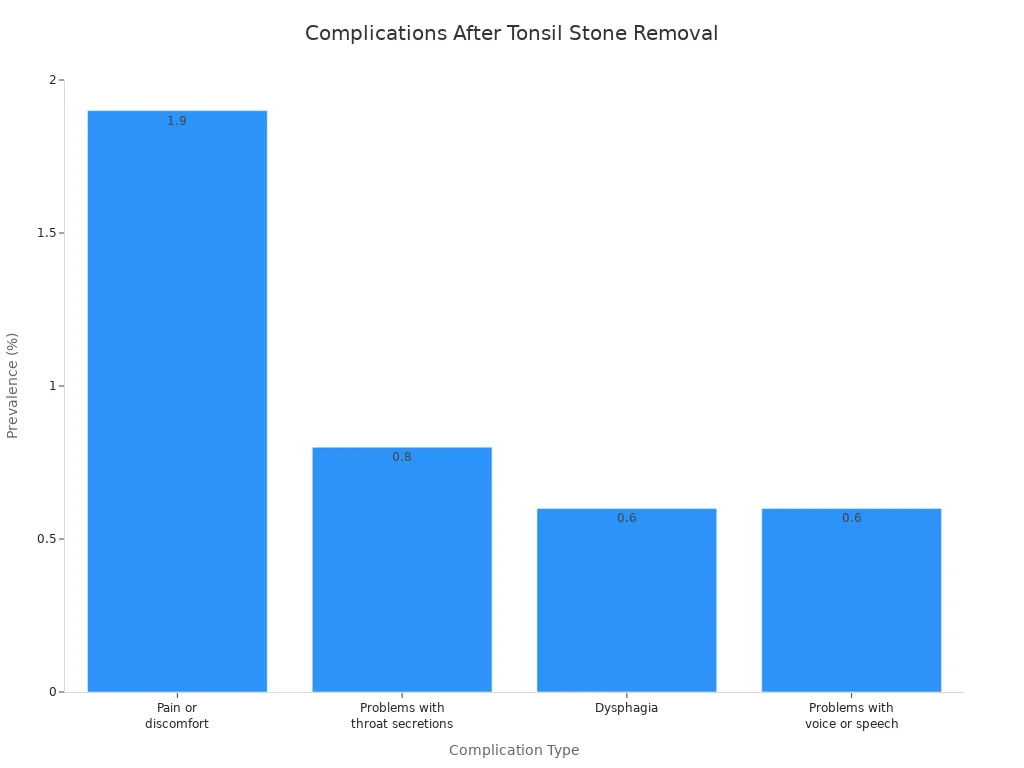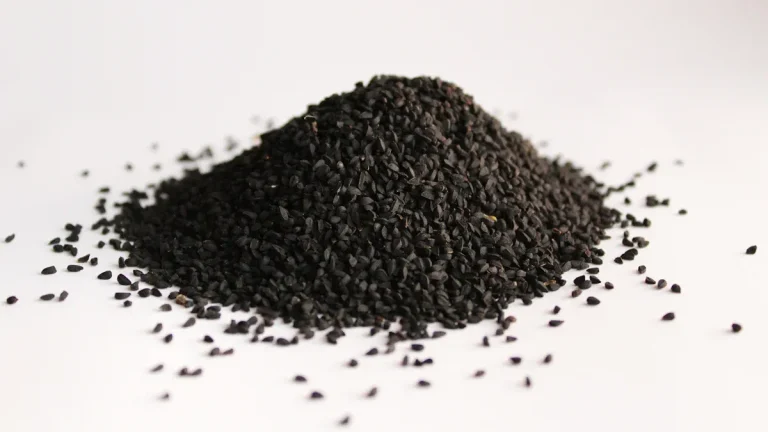
What should you know before removing tonsil stones? You need to understand that tonsil tissue is delicate and can get hurt easily. Studies show that
Up to 40% of people experience tonsil stones at some point in their lives.
Trying to remove a tonsil stone at home can cause problems. Here are some common risks:
Risk Type | Description |
|---|---|
Tissue irritation or bleeding | Using excessive pressure or improper tools can harm the delicate tonsil tissues. |
Deeper stone displacement | Stones may be pushed deeper into the tonsil crypts, complicating removal. |
Infections | Unhygienic removal techniques can lead to infections. |
You should always think about safety first before trying to remove a stone.
Key Takeaways
Tonsil stones can affect many people, but trying to remove them at home can lead to serious risks like infections and tissue damage.
Always prioritize safety by avoiding sharp tools and using gentle methods like gargling with salt water to help dislodge stones.
Good oral hygiene is key to preventing tonsil stones; brush, floss, and gargle regularly to keep your mouth clean.
If tonsil stones cause pain or keep coming back, seek professional help from a doctor for safe and effective removal.
Consider daily habits like using alcohol-free mouthwash and avoiding sugary drinks to reduce the risk of tonsil stones.
Safety Before Removing Tonsil Stones
Risks to Know
Your tonsils are soft and sensitive. When you try to remove tonsil stones at home, you can hurt this delicate tissue. Many people report problems after trying to get rid of tonsil stones themselves. Some of the most common issues include:
Swelling in the throat
A feeling that something is stuck at the top of your throat
Bad breath that gets worse over time
Pain when you swallow, eat, or drink
Trying to remove tonsil stones with your fingers or hard tools can make these problems worse. You might push the stones deeper into the tonsil, which makes them harder to reach. You also risk causing bleeding or even tonsil infections. At-home removal can introduce bacteria, which may lead to infection and damage to the area around your tonsil. Professional removal by a dentist or ENT doctor is much safer because they use special tools and know how to avoid these risks.
Note: Tonsil infections can happen if you use unclean tools or too much force. Always think about the risks before you try to remove tonsil stones by yourself.
Precautions to Take
You can lower your risk of problems by following some simple safety steps. Never use sharp or hard objects to remove tonsil stones. Avoid using your fingers, as this can spread germs and cause tonsil infections. If you want to try at-home methods, stick to gentle options like gargling with salt water or using a water flosser on a low setting. Good oral hygiene helps prevent tonsil stones and reduces the chance of infection.
If you notice pain, swelling, or signs of tonsil infections after trying to remove a stone, you should see a doctor. Professional care is the safest way to handle stubborn or painful tonsil stones.
What Are Tonsil Stones?
Tonsil stones, also called tonsilloliths, are small, hard lumps that form in the crevices of your tonsil. These stones develop when debris like food particles, dead cells, and mucus get trapped in the tiny pockets of your tonsil. Over time, this debris hardens and creates a stone. You might not notice them at first, but sometimes they cause discomfort or bad breath. In many cases, tonsil stones can go away on their own without treatment.
Causes
You may wonder why tonsil stones form. Several factors can make you more likely to develop them. The most common causes include:
Cause | Description |
|---|---|
Poor Oral Hygiene | Not brushing or flossing regularly lets debris build up in your mouth and tonsil pockets. |
Tonsil Size and Shape | Large or uneven tonsils have more spaces where debris can get stuck. |
Chronic Tonsillitis | Frequent tonsil infections can create small holes that trap debris. |
If you keep your mouth clean and healthy, you lower your risk of getting tonsil stones. People with large or bumpy tonsils or those who have had many tonsil infections may notice stones more often.
Who Gets Them
Tonsil stones can affect anyone, but some groups have a higher chance of getting them. Studies show that:
Up to 10% of people have tonsil stones at some point.
Adults get tonsil stones more often than children.
People who have had tonsillitis before are more likely to develop stones.
Demographic Factor | Details |
|---|---|
Sex Predilection | Both males and females get tonsil stones at similar rates. |
Age Range | People from age 9 to 87 can get tonsil stones, but older adults see them more often. |
Previous Tonsillitis | Having had tonsillitis increases your risk. |
You may never notice tonsil stones, or you might find them often if you have a history of tonsil problems. Most people do not need treatment unless the stones cause pain or other symptoms.
At-Home Removal Methods
If you want to try removing tonsil stones at home, you have several options. You should always choose gentle methods to protect your tonsil and avoid making the problem worse. Here is what you can do safely:
Gargling Saltwater
Gargling with warm salt water is a simple way to help loosen tonsil stones. You can prepare the solution by adding one teaspoon of salt to a cup of warm water. Swish the mixture around your mouth and throat for about 30 seconds, then spit it out. This method may help remove small stones and soothe a sore or scratchy throat. Many people find that gargling saltwater also helps with bad breath caused by tonsil stones.
Gargling may loosen stones stuck in the tonsil.
Saltwater can relieve throat discomfort.
You only need salt and warm water to prepare the solution.
Tip: Gargle gently. Do not swallow the saltwater.
Coughing Technique
Energetic coughing sometimes helps dislodge tonsil stones. You may notice a stone come loose after a strong cough. This method does not work for everyone, and you may need to try it a few times. If you feel a stone in your throat, coughing may help move it out.
Coughing can push stones out of the tonsil.
This method is not always effective.
You do not need any tools or special preparation.
Note: If coughing does not work after several tries, you should stop and try another method.
Water Pick Use
A water pick, also called a water flosser, can help remove tonsil stones. You should use the lowest setting to avoid hurting your tonsil. Aim the stream of water at the stone, not directly at the tonsil tissue. This method works best for stones that are easy to see and reach.
Steps for using a water pick:
Fill the water pick with warm water.
Set the device to the lowest pressure.
Gently aim the water stream at the tonsil stone.
Rinse your mouth after use.
Warning: High pressure can damage your tonsil. Always use the lowest setting.
What Not to Do
Some methods for removing tonsil stones can cause serious problems. You should avoid using your fingers, cotton swabs, or any hard objects to poke at the stones. These actions can lead to infection, bleeding, or damage to your tonsil.
Unsafe Method | Possible Problem |
|---|---|
Using fingers | Can introduce bacteria and cause infection |
Using hard objects | May cause bleeding or injury |
Repeated poking | Can damage tonsil tissue and lead to more stones |
Using unsterilized tools or fingers can introduce bacteria into your throat.
Poking at tonsil stones may cause bleeding because the tonsil has a rich blood supply.
Repeated attempts can damage the tonsil and make stones come back more often.
Alert: Never use sharp or hard objects for removing tonsil stones. You risk hurting your tonsil and making the problem worse.
If you cannot remove tonsil stones safely at home, or if you notice pain or swelling, you should see a doctor. Professional help is the safest choice for stubborn or painful stones.
Tonsil Stone Removal by a Doctor
When to Seek Help
You might wonder what symptoms of tonsil stones mean you should see a doctor. Some signs show that at-home methods are not enough. You need professional removal if you notice any of the following:
Severe pain in your throat or ear that does not get better
Persistent bad breath even after brushing and rinsing
Tonsil stones that keep coming back
Large stones that you cannot remove at home
Swelling, bleeding, or signs of infection in your tonsil
Difficulty swallowing or breathing
Many people seek medical help for tonsil stones because of discomfort, poor oral hygiene, or chronic tonsillitis. Enlarged tonsils, dry mouth, and a diet high in dairy or processed foods can also make stones more likely. Bacterial growth and mouth breathing from allergies or nasal congestion may increase your risk. Age can affect your oral hygiene habits and tonsil structure, making tonsil stone diagnosis more common as you get older.
Tip: If you have any of these symptoms, schedule a visit with your doctor or an ENT specialist. Early treatment can prevent more serious problems.
How Are Tonsil Stones Treated
You may ask, how are tonsil stones treated by a doctor? Your doctor will first examine your mouth and throat. They may use a light or a small mirror to look for stones. Sometimes, your doctor will order imaging tests if the stones are deep or hard to see.
Doctors use several methods for tonsil stone removal. The right treatment depends on the size, location, and number of stones. Here are some common options:
Manual removal: Your doctor may use a special tool to gently remove the stone. This method works well for stones near the surface.
Irrigation: Some doctors use a water pick or syringe to flush out stones from the tonsil crevices.
Laser tonsil cryptolysis: This treatment uses a laser to smooth the surface of the tonsil and reduce pockets where stones form. You usually recover quickly from this procedure.
Tonsillotomy: In this minor surgery, the doctor removes part of the tonsil tissue to prevent stones from coming back. Most people recover within about a week.
Tonsillectomy: If you have very large, painful, or persistent stones, your doctor may recommend removing the tonsils completely. This is a last resort when other treatments do not work.
You may wonder what to expect after professional removal. Most people feel better within a few days. If you have a tonsillotomy, about 77% of patients recover fully within two weeks. For a full tonsillectomy, recovery takes longer. Only about 57% of patients feel fully recovered after two weeks. The median recovery time for tonsillotomy is about 7.5 days, while tonsillectomy often takes more than two weeks.
Some people worry about complications after tonsil stone removal. Most side effects are mild and go away quickly. The most common problems include pain or discomfort in the mouth or throat, trouble clearing throat secretions, difficulty swallowing (dysphagia), or changes in voice or speech.
Complication Type | Prevalence (%) |
|---|---|
Pain or discomfort in the mouth or throat | 1.9 |
Problems with throat secretions or clearing | 0.8 |
Dysphagia | 0.6 |
Problems with voice or speech | 0.6 |

Doctors often suggest conservative treatments first. These include improving oral hygiene, using mouth rinses, and staying hydrated. If you have frequent or severe stones, your doctor may discuss more permanent solutions.
Note: Always follow your doctor’s advice after tonsil stone removal. Good oral care and regular checkups help prevent stones from coming back.
Preventing Tonsil Stones
Oral Hygiene Tips
You can prevent tonsil stones by keeping your mouth clean every day. Good oral hygiene removes food particles and bacteria that cause stones to form. Here are some steps you should follow:
Brush your teeth and tongue in the morning, before bed, and after every meal.
Floss daily to remove debris between your teeth.
Clean your tongue regularly to reduce bacteria.
Gargle with salt water to help dislodge food and bacteria from your tonsil.
Regular gargling does more than freshen your breath. It helps clean the tonsil crypts and lowers the chance of stone formation. You can use a mouthwash without alcohol to reduce bacteria and avoid drying out your mouth. The table below shows how gargling helps prevent tonsil stones:
Evidence Description | Implication on Tonsil Stones |
|---|---|
Regular gargling can reduce the occurrence of tonsil stones through mechanical cleaning action. | Supports the idea that gargling may help prevent tonsil stone formation. |
The use of a mouthwash without alcohol can inhibit caseum formation and reduce bacterial populations. | Suggests that specific mouthwash formulations can be beneficial in preventing tonsil stones. |
Gargling creates liquid turbulence that may positively affect the cleaning of tonsil crypts. | Indicates that the act of gargling itself may help in reducing tonsil stone formation. |
Tip: Make gargling with salt water part of your daily routine to keep your tonsil healthy.
Daily Habits
You can lower your risk of tonsil stones by making a few changes to your daily habits. These habits help keep your mouth clean and reduce the chance of stones coming back. The table below lists what you should do:
Daily Habit | Description |
|---|---|
Brush teeth after meals | Helps remove food particles and bacteria that can contribute to tonsil stones. |
Brush tongue | Reduces bacteria buildup on the tongue, which can lead to tonsil stones. |
Floss daily | Removes debris between teeth that can harbor bacteria. |
Use alcohol-free mouthwash | Lowers bacteria levels in the mouth without the drying effects of alcohol-based mouthwashes. |
You should also avoid smoking and limit sugary drinks. These changes help reduce inflammation and bacterial growth in your mouth. Clinical guidelines show that good oral hygiene, regular brushing, flossing, and gargling with salt water are effective ways to prevent tonsil stones. Some people choose surgical options like tonsillectomy or laser cryptolysis for long-term relief, but most people find that daily care works well.
Note: Consistent oral care is the best way to prevent tonsil stones and avoid the need for treatment.
You should always put safety first when thinking about tonsil stone removal. Here are some important tips:
Gargle with warm salt water to ease discomfort.
Use only soft tools and gentle pressure if you try home removal.
Brush and floss every day to keep your mouth clean.
See a doctor if stones are large, painful, or keep coming back.
Good habits can help prevent tonsil stones. If you feel unsure, professional care gives you safe solutions and peace of mind.
FAQ
What should you do if tonsil stones keep coming back?
You should talk to your doctor if tonsil stones return often. Your doctor may suggest better oral care or discuss surgery. Surgery can remove part or all of your tonsils to stop stones from forming.
What is the role of surgery in treating tonsil stones?
Surgery can help when tonsil stones cause pain or do not go away. Doctors may remove the tonsils or smooth their surface. Surgery is usually a last step if other treatments fail.
What happens during tonsil stone surgery?
During surgery, your doctor removes the tonsils or changes their surface. You may get local or general anesthesia. Surgery can prevent future stones. Most people recover in one to two weeks after surgery.
What are the risks of surgery for tonsil stones?
Surgery has some risks. You may feel pain, have bleeding, or get an infection. Some people have trouble swallowing after surgery. Your doctor will explain the risks before you decide on surgery.
What can you expect after surgery for tonsil stones?
After surgery, you may feel sore and tired. You should rest and drink fluids. Most people recover quickly. Surgery can stop tonsil stones from coming back. Your doctor will give you tips for healing after surgery.


